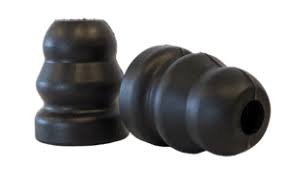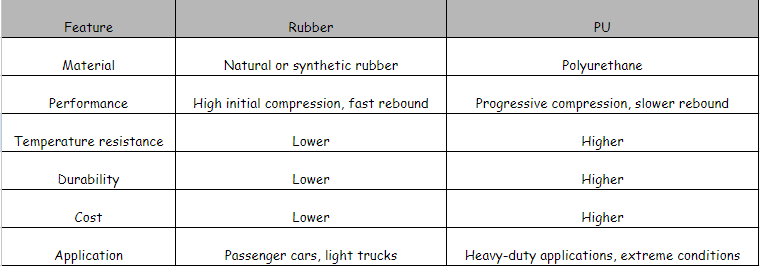Rubber vs. PU Bumpstops: A Head-to-Head Comparison
- Post On12.9.2022
- ByNiket Lachake
Introduction
Bumpstops, the unsung heroes of suspension systems, absorb impact and protect vital components from damage. Choosing the right one can significantly impact your vehicle's performance and lifespan. But with two main contenders – rubber and PU – the decision can be tricky. Let's dive into a head-to-head comparison to help you make the informed choice.
The Showdown: Rubber vs. PU
| Feature | Rubber | PU |
|---|---|---|
| Material | Natural or synthetic rubber | Polyurethane (synthetic) |
| Performance | High initial compression, fast rebound | Progressive compression, slower rebound |
| Temperature Resistance | Lower (may degrade in extreme heat or cold) | Higher (performs well in hot and cold conditions) |
| Durability | Lower (prone to wear and tear) | Higher (more resistant to abrasion and fatigue) |
| Cost | Lower (budget-friendly option) | Higher (depends on formulation) |
| Application | Ideal for comfort and noise reduction (passenger cars, light trucks) |
Suited for heavy-duty applications and extreme conditions (off-road vehicles, industrial machinery) |


.
Deep Dive: The Pros and Cons
Rubber: The Comfort King
- Excellent vibration dampening and noise reduction for a smoother ride.
- Affordable option for budget-conscious drivers.
- May degrade faster in extreme temperatures or with heavy use.
- Fast rebound can impact ride quality and handling.
PU: The Durability Champion
- Progressive compression for improved handling and control.
- Superior durability and wear resistance for longer lifespan.
- Higher temperature resistance for various weather conditions.
- May be more expensive than rubber, depending on the formulation.
- Slower rebound can feel less responsive at times.

Choosing the Right Bumpstop for You
Ultimately, the best bumpstop material depends on your specific needs and priorities. Consider these factors:
- Vehicle type and usage:** Heavy-duty applications or extreme conditions demand PU's sturdiness. Passenger cars prioritize rubber's comfort.
- Budget:** Rubber offers affordability, while PU may require a higher investment.
- Performance preferences:** Do you prioritize comfort and noise reduction (rubber) or handling and control (PU)?
Remember, bumpstops are vital for your vehicle's health and performance. Choose wisely and enjoy the smooth ride!
